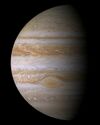Astronomy:Chinese Jupiter probe
| Mission type | Jupiter orbiter |
|---|---|
| Operator | CNSA |
| Spacecraft properties | |
| Manufacturer | CAST |
| Start of mission | |
| Launch date | 2029 (proposed) |
| Jupiter orbiter | |
| Orbital insertion | 2035 (proposed) |
Gan De is the tentative name for a proposed interplanetary mission by China to study the Jupiter system and its environs.[1]
Overview
The goals of the proposed Gan De Jupiter mission were detailed in an article published in a Chinese academic journal, they include the following: study of the interaction between magnetic fields and plasma present in the Jovian system, examination of the compositional variations in the Jovian atmosphere, exploration of the internal structures and surface characteristics of either Ganymede or Callisto, as well as investigation of the space environment surrounding the aforementioned Galilean satellites.[2]
According to reports in the Western media, there are two competing mission profiles as of January 2021: the 'Jupiter Callisto Orbiter' (JCO) and the 'Jupiter System Observer' (JSO).[1] 'JCO' would involve a spacecraft conducting fly-bys of Jupiter's irregular satellites before it enters into a polar orbit about Callisto; this mission profile also may include a Callisto lander. In contrast, the 'JSO' mission profile, while broadly similar to that of 'JCO', would forgo an attempt by a spacecraft to orbit Callisto and instead would focus on more intensive studies of the Galilean moon Io (the 'JSO' mission profile also does not appear to include a lander though it may involve sending the spacecraft to the Sun-Jupiter L1 point at the conclusion of its tour of the Jovian system). Finally, presentations by Chinese researchers suggest that the Gan De Jupiter mission may include an additional probe that would conduct a fly-by of Uranus sometime after 2040.[3]
The tentative name of this mission references the fourth century BCE Chinese astronomer 'Gan De' who made early planetary observations and reputedly first observed the Galilean moons with the unaided eye.[1]
Background
On October 15, 2003, CNSA launched China's first independent crewed orbital mission; subsequently it prosecuted successful robotic lunar orbital missions (Chang'e 1 and Chang'e 2) and a robotic lunar lander/rover mission (Chang'e 3). In the hope of building upon these achievements, CNSA began to contemplate more ambitious interplanetary missions in the 2020's and beyond. In 2018, Pei Zhaoyu, the deputy director of CNSA's Lunar Exploration and Space Program Center stated that China was planning to conduct four major interplanetary missions before the end of the 2020's;[4] the four missions include a mission to Mars (Tianwen-1), a main-belt comet and asteroid sample-return mission (ZhengHe), a Mars sample-return mission, and a Jupiter system mission. As of early 2021, the aforementioned 'JCO' and 'JSO' mission profiles are competing to be realized as the Gan De Jupiter system mission.[1]
Instruments
Currently there is scant publicly-available information in the western media regarding potential instruments for this mission, though it is likely that these would include a magnetometer, charged and neutral particle detectors, and spectrometers at various wavelengths. In addition, both the JCO and JSO mission profiles include CubeSats that would carry particles and fields detectors.[1]
References
- ↑ 1.0 1.1 1.2 1.3 1.4 Jones, Andrew (12 January 2021). "Jupiter Mission by China could include Callisto Landing". https://www.planetary.org/articles/jupiter-mission-callisto-landing.
- ↑ Xu, Lin; Zou, Yongliao; Jia, Yingzhuo (2018). "China's planning for deep space exploration and lunar exploration before 2030". Chinese Journal of Space Science 38 (5): 591–592. doi:10.11728/cjss2018.05.591. http://epizodsspace.airbase.ru/bibl/inostr-yazyki/Chinese_Journal_of_Space_Science/2018/5/Xu_et_al_China's_Planning_---_before_2030_Chin_J_Space_Sci_38_(2018).pdf.
- ↑ Jones, Andrew (14 July 2017). "Mars, asteroids, Ganymede and Uranus: China's deep space exploration plan to 2030 and beyond". https://findchina.info/mars-asteroids-ganymede-and-uranus-chinas-deep-space-exploration-plan-2030-and-beyond.
- ↑ "China outlines roadmap for deep space exploration – Xinhua | English.news.cn". http://www.xinhuanet.com/english/2018-04/25/c_137136188.htm.
External links


